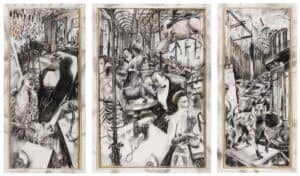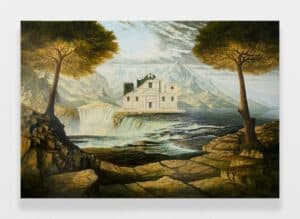Bill Jacklin, who has shown with Marlborough Fine Art for almost 40 years, returns to the gallery with an exhibition of recent paintings and a selection of monotypes on until 29th June 2019.
 Bill Jacklin, ‘Advancing Storm with Figure II’, 2019, oil on canvas, image credit Boris Apple
Bill Jacklin, ‘Advancing Storm with Figure II’, 2019, oil on canvas, image credit Boris Apple
Although mainly figurative in presentation, many of the works show underlying systems of abstraction. There is a coexistence of representation and abstraction provoking a tension which results in an augmented viewing experience.
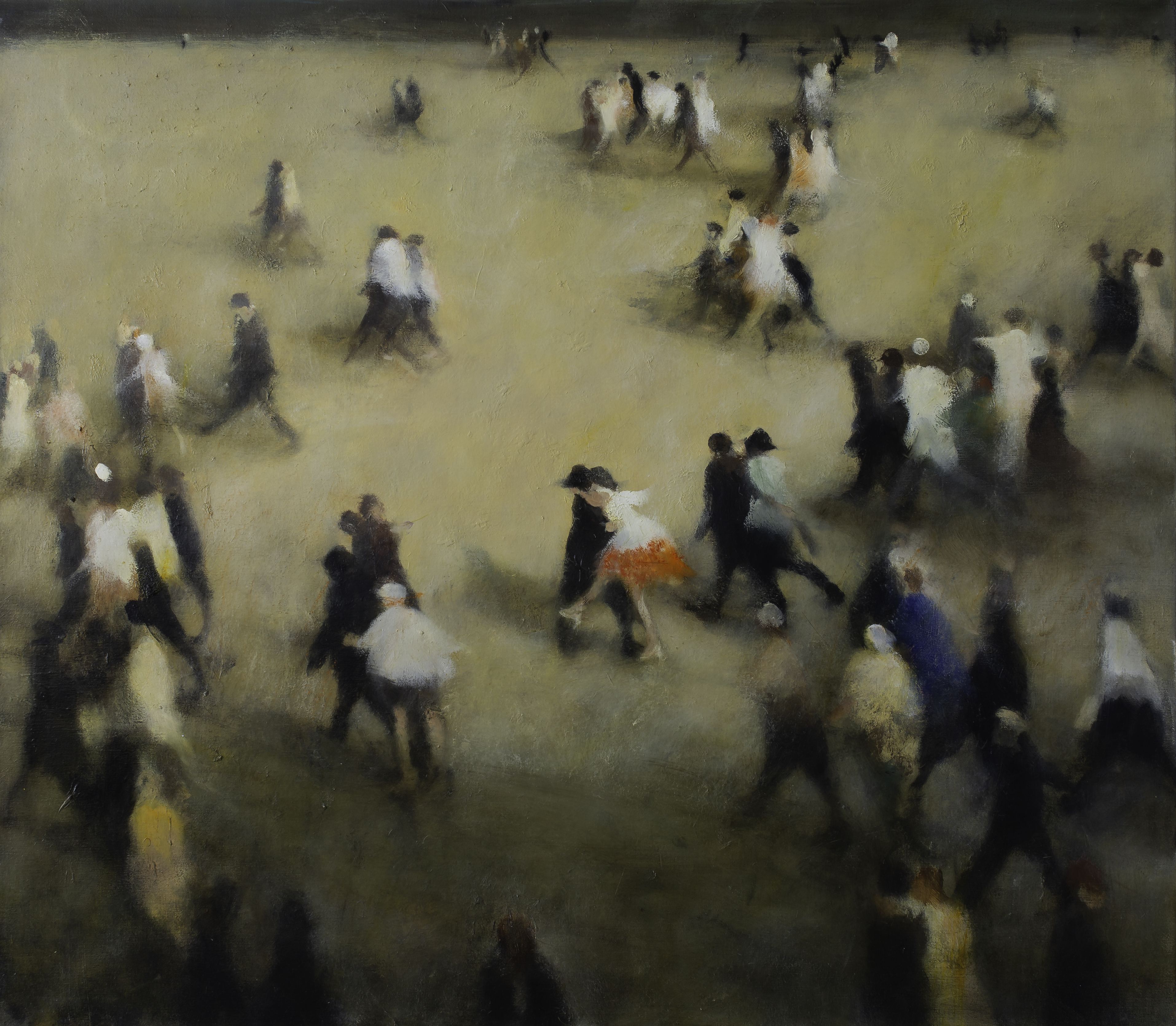 Bill Jacklin, ‘Concourse Kiss’. 2019, oil on canvas, 42 x 48 inches, image credit Boris Apple
Bill Jacklin, ‘Concourse Kiss’. 2019, oil on canvas, 42 x 48 inches, image credit Boris Apple
Formerly based in New York, Jacklin is best known for his paintings depicting the pulsating energy of Manhattan crowds. A recent move out of the city to Rhode Island has brought a more pastoral influence to newer pieces. The energy is the same, and, as you will read in this interview, the focus remains on movement and change.
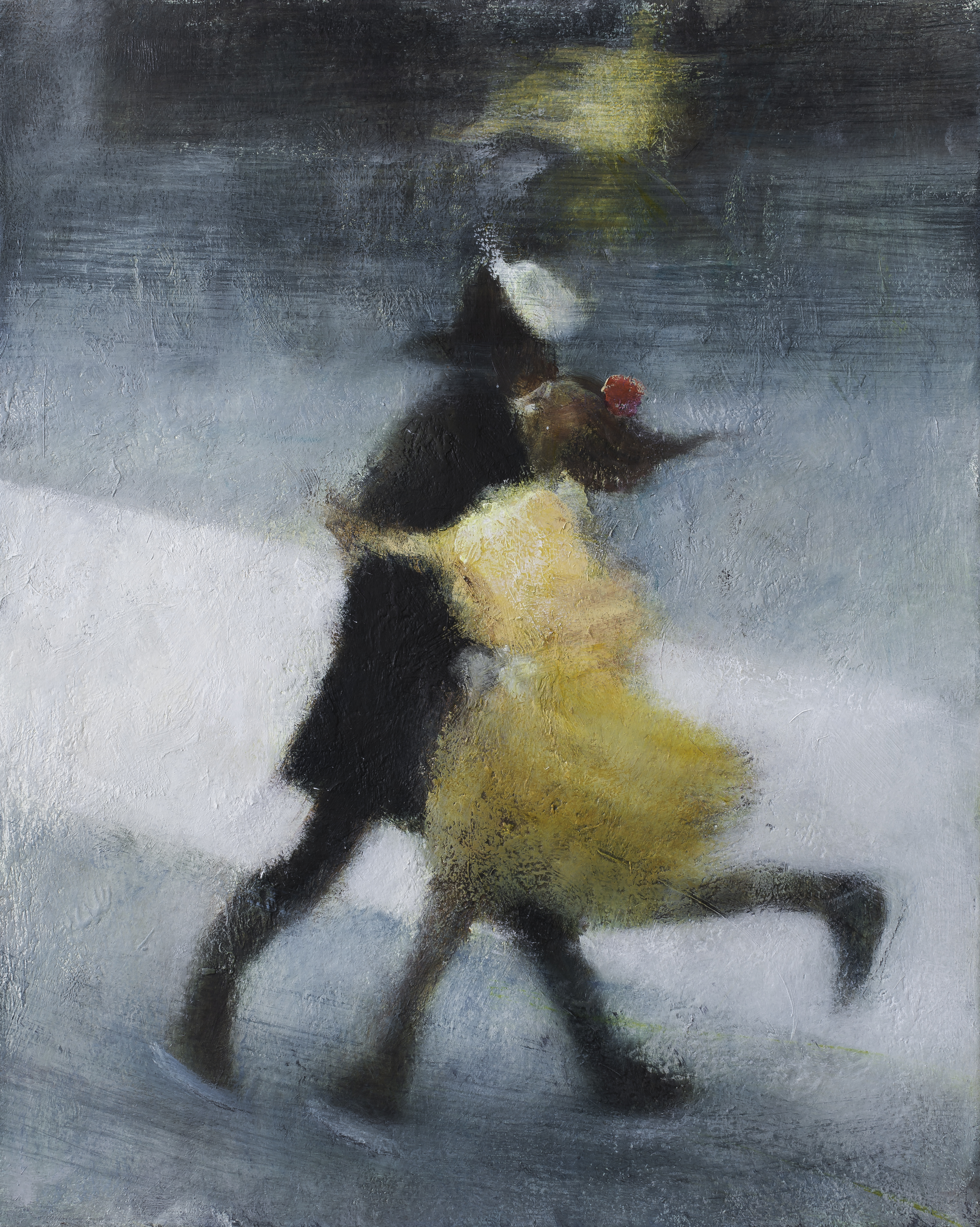 Bill Jacklin, ‘Two Skaters’, 2019, oil on canvas, 16 x 20 inches, image credit Boris Apple
Bill Jacklin, ‘Two Skaters’, 2019, oil on canvas, 16 x 20 inches, image credit Boris Apple
For this exhibition, Jacklin has created ‘The Singer in the Square’ series. Here, we see the rhythmic flow of people; their dynamic and harmonic movements throughout some rural landscape. This sense of flux and flow inhabits also his works resulting from his time spent sketching in the Piazza della Repubblica in Florence, Italy. There, Jacklin curiously observed accidental meetings or individuals simply going about their business.
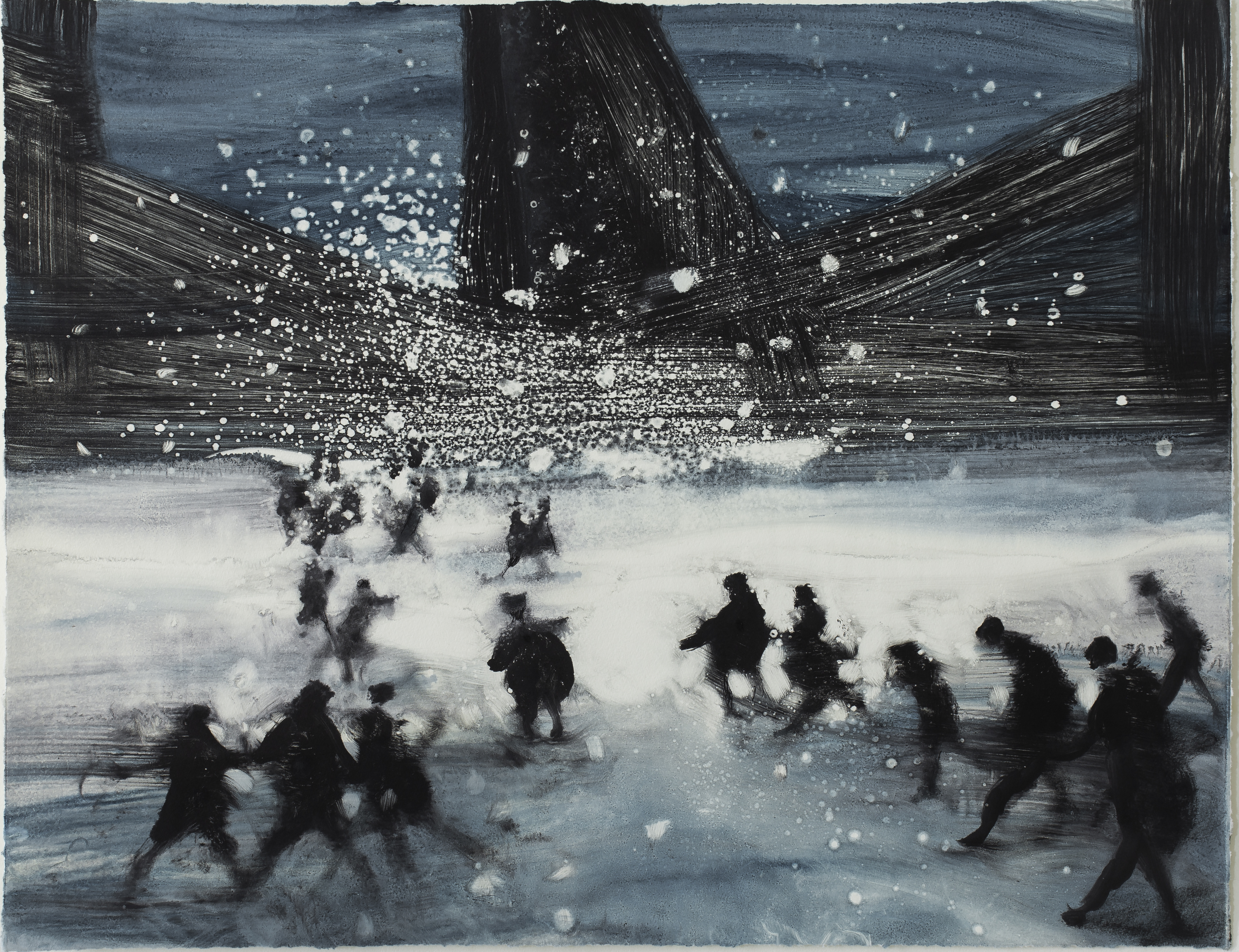 Bill Jacklin, ‘Storm in the Square I’, 2019, monotype, 21.5 x 27.5 inches, image credit Boris Apple
Bill Jacklin, ‘Storm in the Square I’, 2019, monotype, 21.5 x 27.5 inches, image credit Boris Apple
Whereas all works share an interest in a realistic representation of people and places, figures never fully emerge. Crowds and nature are, rather, always obfuscated by a nebulous layer of paint. Either dotted or evenly spread out, this thin layer of semi-transparent colour blurs shapes and places.
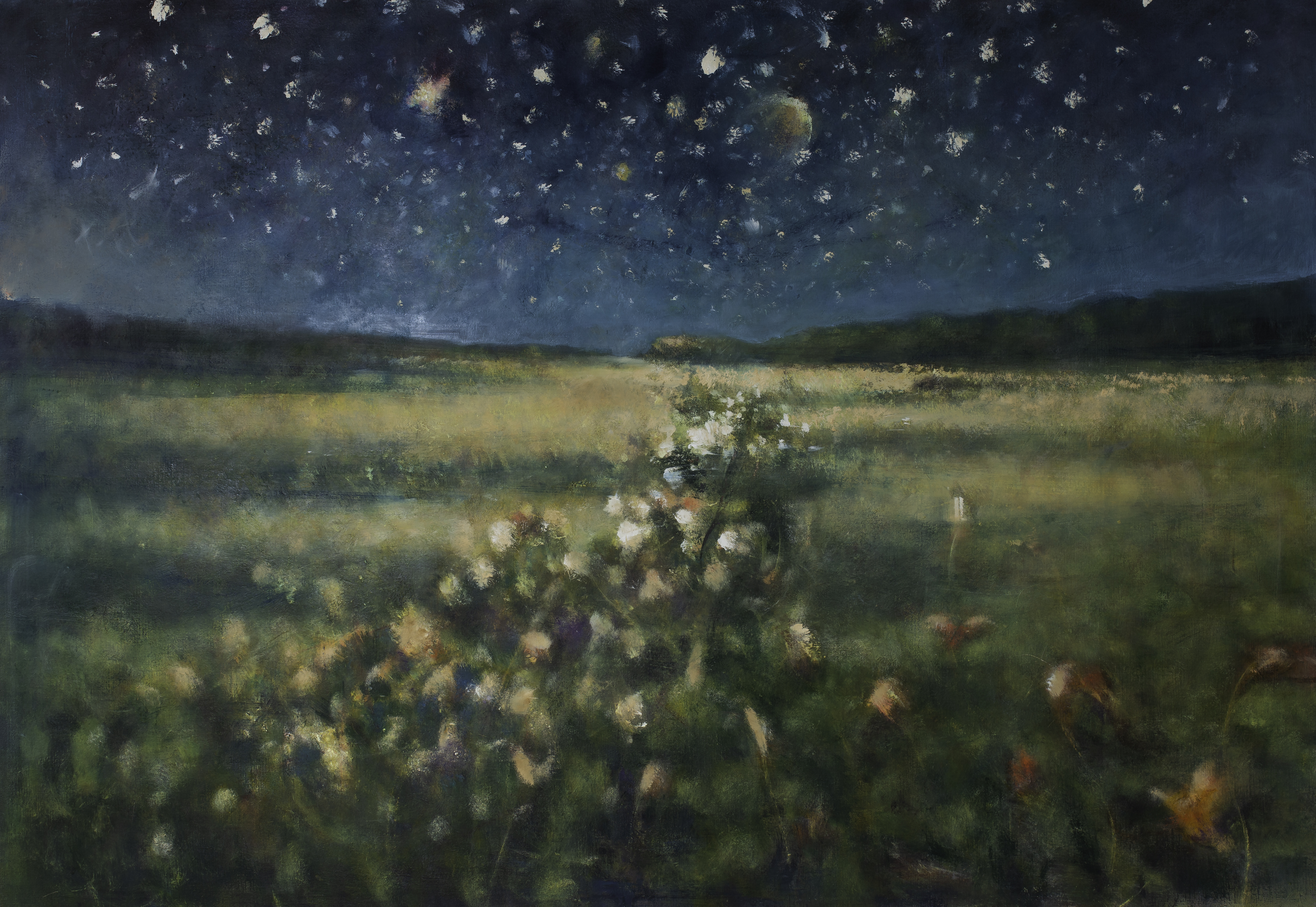 Bill Jacklin, ‘Field at Night’, 2018, oil on canvas, 50 x 72 inches, image credit Boris Apple
Bill Jacklin, ‘Field at Night’, 2018, oil on canvas, 50 x 72 inches, image credit Boris Apple
Read my interview with Bill:
- Dear Bill, thank you very much for this interview. Looking at your work, I noticed a clear interest in figuration. Yet, figures are at times blurred, other times fading away or covered by white dots of paint. They are never fully there. Do you notice this tension as well? Why do you create it?
The effect you describe is due to my preoccupation with light. A primary aim in my work is to explore the modulation of the tonal rhythm of light to dark and back again. Consequently my process involves the destruction and buildup of the figurative image and back again in order to give it spatial strength. I often paint figuratively before stripping away layers of oil paint, to then built them up again. In searching for magic, my process therefore involves a significant degree of risk, whereby I obliterate images to bring them back stronger.
- How did your interest for crowds start? And for natural landscapes and phenomena?
My interest in crowds primarily stems from my interest in movement and change; a preoccupation evident throughout my practice. In my early work, you will see that I explored the movement in nature. Later works continuted this interest through exploring, for example, the flux and flow of human figures as they moved through the great ‘canyons’ of New York buildings.
- What are you trying to capture in your works?
My works aim to capture a sense of light, movement and place. As mentioned above, the overall concern in my work is the modulation of the tonal rhythm of light to dark and back again. This is the emotional context of the work. From an early stage in my career I have also had a great interest in movement. This interest runs through both natural phenomena and human activity – from the wind and waves to the pulsating crowds of New York City. But my works would not be complete without a sense of place. They are a representation of how I see the world. Capturing this vision through paint is a visual challange that enoucerages me to experiment sytlistically.
- What triggers them?
It is almost always a combination of receiving an impression from a particular place and an involvement with the process and systems of painting that I would be concerned withat the time. The energy comes from that duality and then a transformation might occur and the work stands a chance of having some resonance.
- I feel a mix of nostalgia and curiosity in your works. How do you experience them? Is to more a recollection of memories and past sensations or a projection to an unexplored future? Or even a reflection and elaboration on something you personally lived?
I do often work from memory as one’s mind can roam and encompass more than one scene or sensation. Projecting into an imaginary future is all part of one’s freedom of expression. Working in the studio might differ from making drawings in my sketchbook. Those drawings often depict the basic essentials of what interests me about a place.
There are many parts to realising an image although the final painting ambition will be to achieve a plastic and convincing resonance in its own right.I am also thinking of what might be the next stage in the evolution of the work. This might be another painting. I often think in series, particularly in the monotypes, suggesting the movement of form and light and my emotional relationship to the works.
- What is your creative process? Does it starts from a realistic depiction that you then blur?
My creative process encompasses a significant level of destruction. After painting in oils, I often use a Black and Decker sander among other tools to strip away layers of paint, which I might then choose to build up again in order to achieve the spatial resonance I want. As I work, I am always in search of magic and therefore explore multiple different effects. As I explained above, I am prepared to take a great deal of risk, obliterating images in the hope of bringing them back stronger. As I paint, I also tend to use opposing forces … black and white … light and dark … and everything in-between. In terms of my style, from a young age I have always been committed to following my own vision.
Bill Jacklin: Paintings and Monotypes Marlborough Fine Art, London through to 29th June 2019



